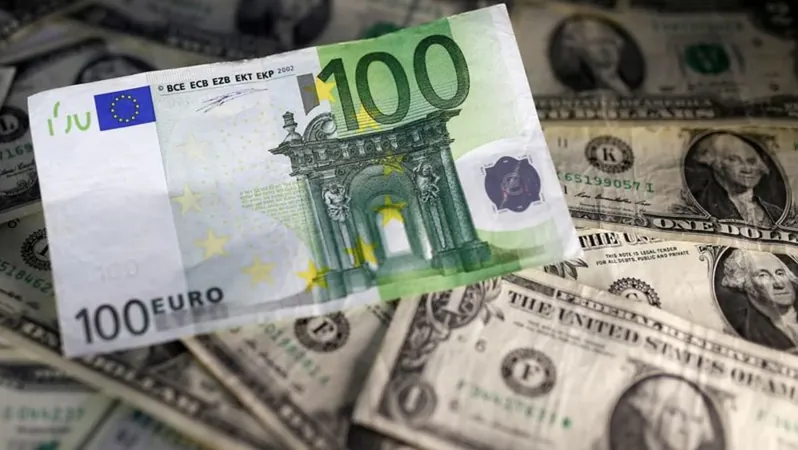
Euro Plummets: Is a Drop to $1 Inevitable?
2024-11-13
Author: Sarah
**LONDON**: The euro is currently experiencing a steep decline, hitting one-year lows and reigniting speculation that it may soon hit the pivotal $1 mark. Analysts are drawing connections to the recent political shift in the U.S. following Donald Trump's election win, which has increased fear of new tariffs that could impact the euro zone economy further.
Currently trading at approximately $1.06, the euro has fallen nearly 5% from its peak in September, where it was consistently performing above the $1.10 range. Concerns about an increasingly weakening economic forecast have exacerbated this downtrend.
1. Will the Euro Hit $1?
The prospect of the euro reaching parity with the dollar is certainly realistic, as it is now just about 6% away from that threshold. Historically, the euro has dipped below this level a few times, notably during the early 2000s and for several months in 2022, amidst both rising U.S. interest rates and energy price surges due to geopolitical tensions stemming from Ukraine's ongoing conflict.
A drop to the $1 mark could worsen negative sentiments surrounding the euro and may spur a further depreciation as traders react to this significant psychological level. Major financial institutions, including JPMorgan and Deutsche Bank, predict that tariffs could trigger this decline, thereby increasing the dollar's allure in the international market, particularly if U.S. inflation continues to surge.
2. Implications for Businesses and Households
A weaker euro typically escalates import costs, inevitably driving up prices for essentials such as food, energy, and raw materials, which could contribute to inflationary pressures. While European inflation has notably decreased from double-digit figures seen two years ago, the potential impacts of a declining euro are concerning for consumers. However, many economists anticipate inflation will stabilize around the 2% target within the next year, dismissing immediate panic.
Conversely, a declining euro can benefit exporters by making their goods cheaper for foreign markets, which is particularly advantageous for sectors like automotive and luxury retail. It is worth noting that the German economy, regarded as Europe's powerhouse, is poised to reap the rewards amid a weaker euro, especially given the challenges it has faced from external pressures, such as a faltering Chinese economy.
3. Is the Euro Alone in This Downturn?
Not quite. The euro is not isolated in its struggles; numerous currencies from key U.S. trading partners have depreciated significantly amidst tariff fears. Over the past month, the euro has lost around 4.75%, while the Mexican peso and South Korean won have both seen comparable drops. Interestingly, during Trump's previous term, the euro initially rallied before declining sharply, illustrating its volatility.
Additionally, Japan's yen has plunged almost 9% this year against the dollar, demonstrating that the euro’s performance is, in fact, part of a broader trend affecting multiple currencies.
4. Is the Euro's Future Really Dismal?
While several investment analysts hold a cautious outlook concerning the euro's fate, optimism persists among some economists. Although parity with the dollar is feasible, many believe it is not a certainty. If the European Central Bank (ECB) opts for aggressive interest rate cuts compared to their U.S. counterparts, this could weigh down the euro; however, lower interest rates could also stimulate economic growth, which may counteract some of the euro's decline.
In the third quarter, the euro zone economy outperformed expectations with a growth of 0.4%, suggesting potential for economic recovery, which may bolster the euro's position in the long term.
5. Implications for the ECB
The ECB finds itself in a more favorable situation compared to the last significant euro decline in 2022, when rampant inflation pressured it to raise interest rates. Today, the trend is downward, offering the ECB breathing room.
The central bank is focused on the euro's performance against a basket of currencies from its primary trading partners rather than just the dollar, providing a more comprehensive outlook of its strength. Presently, the trade-weighted euro has only dipped around 1.25% recently, remaining stronger than levels observed in 2022, which could mitigate potential rate-cut delays.
In conclusion, while the euro navigates turbulent waters, there are signs of resilience and possibilities for recovery. As traders and consumers alike watch closely, the future of the euro remains a topic of intense scrutiny and debate. Will we see it plummet to $1, or will a turnaround occur? Stay tuned, as the economic landscape continues to evolve!

 Brasil (PT)
Brasil (PT)
 Canada (EN)
Canada (EN)
 Chile (ES)
Chile (ES)
 España (ES)
España (ES)
 France (FR)
France (FR)
 Hong Kong (EN)
Hong Kong (EN)
 Italia (IT)
Italia (IT)
 日本 (JA)
日本 (JA)
 Magyarország (HU)
Magyarország (HU)
 Norge (NO)
Norge (NO)
 Polska (PL)
Polska (PL)
 Schweiz (DE)
Schweiz (DE)
 Singapore (EN)
Singapore (EN)
 Sverige (SV)
Sverige (SV)
 Suomi (FI)
Suomi (FI)
 Türkiye (TR)
Türkiye (TR)